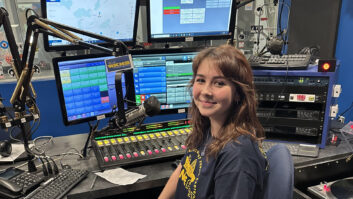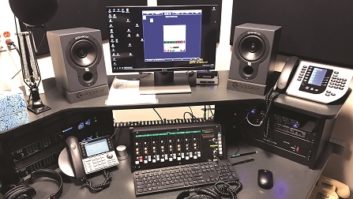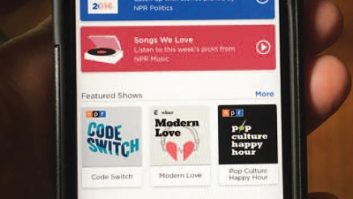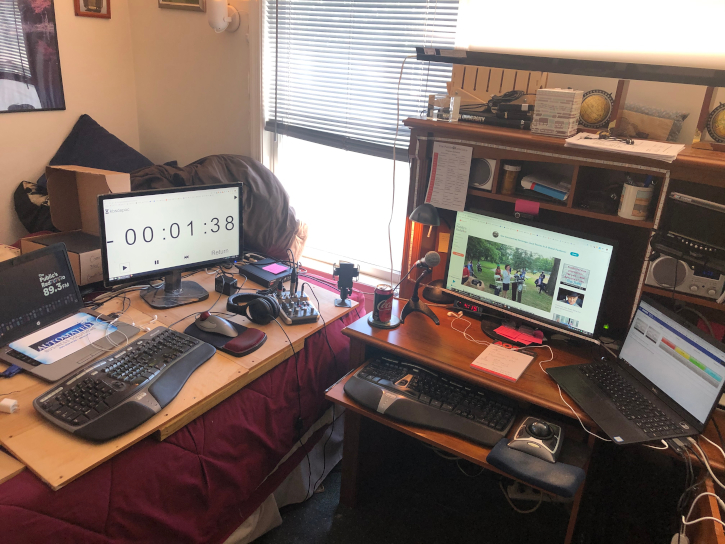
The author is IT and engineering director of The Public’s Radio/Rhode Island Public Radio, on whose website the original version of this article appeared.
In March 2020, The Public’s Radio, aka Rhode Island Public radio, was in the middle of a pledge drive when the coronavirus hit Rhode Island full-force and the lockdown began. We cancelled the drive to focus on the extraordinary events of those early days.
Now, more than three months later, well, events are still pretty extraordinary, but bills also have to be paid. So we conducted a two-day drive on June 25 and 26.
The day before the drive started I wrote the following summary of the operational and engineering challenges we faced, along with a followup piece after the drive to see how it all worked.
With luck, this might be a handy template for other stations to shamelessly use on their own pledge drives.
The Overall Challenge: W.F.H.
The biggest issue is also the broadest: we invest a lot of time, money and effort in our studios at 1 Union Station in Providence, R.I., to be reliable, functional, and ready to be used for any broadcast schema … including pledge drives … with little advance work needed.
Unfortunately, we can’t use them for that now.
There’s one person in the mic booth (our Studio B), namely the host (Chuck Hinman or Dave Fallon), to deliver the news. And one person in the control room (our Studio A), namely James Baumgartner, handling all the operations and “driving” the mix board. Everyone else is WFH or work from Home. So we had to replicate a ton of functionality at multiple home studio locations.
The “Pitchers”
The people listeners hear during a pledge drive are called pitchers. They’re chosen mostly because they sound good on the air. Since we all work in radio, almost everyone on our approximately 20-person staff is “in the bullpen” and can be a pitcher, usually in one- or two-hour chunks for three to six times in the week-long drive. That’s a little too complex to replicate here, so we narrowed the scope a bit:
- Two-day pledge drive;
- Two shifts per day; morning 6 a.m.–12 noon and afternoon 2 p.m.–6:30 p.m.;
- Six pitchers, six locations. Two active per shift;
- Two designated pledge producers. One active per shift;
- One operational manager at the studio (who graciously pulled long hours by running things for the entire drive, both days).
Setting Up a Home “Studio”
Last December we migrated our entire computer and network schema to a mobile-friendly design. Instead of desktops and fixed workstations at the studios, everyone received Dell Latitude 5500 with Core i7 CPU laptops. We moved all our document and file management to the G Suite (AKA Google Docs) cloud as well. Talk about good timing!
Not everyone set things up quite like this, but the preferred layout is:
- External monitor, connected via HDMI;
- Laptop screen available as a second monitor, in extended display mode;
- External keyboard/mouse;
- External webcam is nice, but the built-in webcam is fine;
- AC power is necessary (the laptop batteries are good but not THAT good).
There’s also the very real issue of acoustics.
Most folks don’t realize just how noisy their home is, until you turn on a mic inside it. First off, your family might be stuck at home, too, maybe with barking dogs and small kids. Then there’s cars/trucks driving by, birds singing, lawnmowers, kitchen appliances … all things that can make a lot of noise. Plus many of us live in the city, so we’ve got neighbors and they might have their own barking dogs and (loud) small children, too.
And it could be quite warm or cold during your drive, so keeping cool or warm is a real concern. Some of us are lucky to have central air conditioning, which tends to be pretty quiet but many don’t. Your Intrepid Engineer, who’s a stickler for noisy things, just happened to invest in these new “ultraquiet” Midea U Inverter window-unit air conditioners, which are specially designed to be a lot quieter than most window-unit ACes, which are noisy as hell.
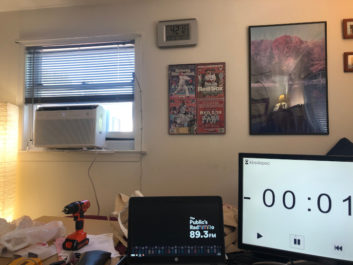
Side note: I can attest that those Mideas really are that wonderfully quiet, but they’re kind of a pain to install and rather heavy.
Some of our folks liked the heat and went without AC at all … meaning open windows and fans. Windows mean a lot of outside noise, and fans blowing air over a mic is very audible as “wind noise.”
There aren’t really any guaranteed solutions here, you just have to keep the fundamentals in mind and be flexible:
- For a room with hard walls/floor, some towels (ideally beach towels) thumbtacked to the walls can help a great deal;
- If you use a noisy window unit AC, or a fan, to stay cool, position things so you can shut them off right before you “go live” on air, and then turn’em back on after the break so you don’t roast;
- If you have the option, put your home studio in the room on the opposite side from the street (or the noisy neighbors) to help minimize the impact;
- If you have pets? Having Fido bark, or Fluffy meow, once or twice while on the air is “authentic.” Having Fido go into “warp spazz home defense mode” because the mailman is here, or Fluffy decide “how dare you ignore me!” and swat your equipment off your table? Not so much. Keep the door closed and Fido or Fluffy stay elsewhere in the house;
- Above all remember that part of the message is that your station is going to great lengths to deliver quality news to your audience and still keep its employees safe in a pandemic. Background noise from the home just lends authenticity to things. In the end, there’s often not much you can do but roll with it anyways, and generally speaking, public radio audiences are pretty accommodating these days.
Getting On the Air
We have several Comrex devices that are ideal for this sort of thing. The Comrex boxes are basically like a Skype call over the internet, just on steroids: better audio quality, more control over things, more resilient to changing network conditions, etc.
There’s a lot of companies that make these devices for broadcast radio … The Telos Alliance, Tieline, MUSICAM, WorldCast, etc. … but we happened to end up with more Comrexes than the others. Partly by chance, partly because Comrex’s HQ is in Devens, Mass., northwest of Boston.
It’s been handy at times that I could just drive two hours and drop off a broken unit, pick up a loaner, and be back in business in half a day.
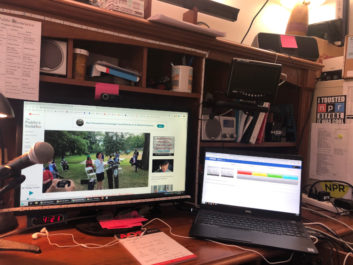
We had one Comrex Access 2USB already, and we rented three more from Silver Lake Audio. Most pitchers will have a beyerdynamic DT290 broadcast-quality headset mic; good sound, easy to use, and comfy to wear for long stretches.
Every Access was prepped ahead of time by me with these features:
- Network connections were prepped for both ISP connections on the Access;
- All were named “RIPR ACCESS1,” “RIPR ACCESS2” and “RIPR BRICLINK2” to make it consistent;
- The “name” of each Access 2USB was changed to be the name of the pitcher; makes it easier for the guy in the studio to keep track;
- The F2 button on the Access 2USB was set to be a shortcut to the “Remote Connections” page;
- The profile is 64 kbps CBR Opus Mono, with delay set to 150 ms minimum, 1000 ms maximum.
We went out of our way to use wired Ethernet connections for each Access 2USB. These units are relatively old (they’ve been succeeded by the Access NX) and while they still work fine overall, they can have issues with modern Wi-Fi security protocols. In two cases, I picked up a cheap Wi-Fi extender (a TP Link AC750; I have some at my house and they work well), connected it to a pitcher’s Wi-Fi, and then plugged the wired Access 2USB Ethernet jack to the wired jack on the extender. A little goofy, but it works!
Back at the studio we had a Comrex Access Rackmount already set up for things like this, and I repurposed a Comrex BRIC-Link II for this drive as well. This way, we can accommodate two remote pitchers at a time.
Communicating Off the Air
A surprisingly difficult problem proved to be behind the scenes communications between the pledge producer and the pitchers.
In the studio, this is easy; our intercom system allows the producer in Studio A to talk into the one ear of the headphones for any one of the four mics in Studio B. We don’t have that luxury here, so we had to homebrew it using the Zoom internet-based conferencing system.
We picked up a bunch of cheap earbud headsets with a 3.5 mm TRRS plug. I got iHip APP3s for $10 each at Walgreens. The idea is you wear one earbud, then put your beyerdynamic DT290 headphones on over it. Sound quality doesn’t really matter, here … all that matters is comfort when you’ve got closed-ear headphones over the earbud in the same ear.
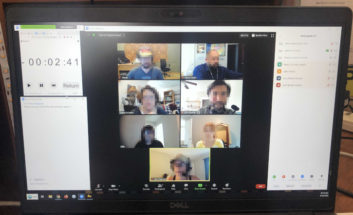
The pledge producer hosts the Zoom call (we paid for a pro account for the station), and mutes everyone. Everyone stays muted while the pitchers are live; the Zoom is only for use in between breaks or during emergencies. We even had people intentionally unmute while “pitching” in a dry run, so you can hear how amazingly distracting it is to have someone talking in your ear while you are also trying to talk.
We made sure everyone knows how to use the “hold down the spacebar to unmute” trick in Zoom. (Pro Tip: you have to select the Gallery window of Zoom first before the spacebar trick will work!) I also distributed a quick guide to the common broadcasting hand gestures so the producer can use them in the video part of Zoom.
The real hell of this was Windows 10. Its efforts to “manage” sound devices are absolutely execrable, and we spent a lot of time making sure everyone’s laptop was correctly auto-sensing the earbuds being plugged in, and then Zoom using the earbuds for the mic/headphones. It really wants you to just use the laptop’s speakers and mic array … but the problem is it’ll feedback over the Comrex links if the pitchers use that method.
Staying on Time
Something your Intrepid Engineer realized early on was the need to have people at remote locations stay coordinated in time, down to the second.
In normal times, both Studio A and Studio B each have two ESE clocks: a red one that’s just HH:MM:SS and synched to a GPS-controlled master clock, and an amber one that’s a countdown timer, controlled by a panel in Studio A. Since public radio stays in coordination between member stations and NPR central via precise timing and “programming clocks, these ESE clocks and timers are critical … and we don’t have them at any of these home studios.
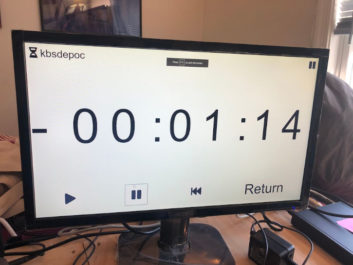
Well, one thing we can do is make sure everyone’s computer clock is synchronized, and fortunately that’s easy. Windows does a decent job already, but if you want the real deal, download NetTime from here. That’s a start, but what about countdowns?
There’s two ways you can do this.
One is for the operations guy in the studio (or the pledge producer) use Zoom to “screen share” a web page where you’ve just googled the phrase “countdown timer.” Google has one and it works pretty well, all things considered. The only drawback is that it’s tricky managing the screenshare, and there’s a bit of a lag in Zoom video so that timer could easily be a second or two off of “real time.” That’s not ideal, but it’s perfectly manageable.
We decided to go a little further, and hired a freelancer to code up a synchronized countdown timer in Javascript. Anyone is free to use it, it’s right here: When you create a new countdown timer, it auto-generates a random 8- or 9-character alphanumeric ID code. Share that code with other people, and they can go to that same website, enter the ID code, and now the timer they’ll see is perfectly synchronized with the master one.
Staying on Script
While we encourage our pitchers to “improve” as they talk on air, everyone has a written script to work with. It’s meant so that you can choose to just read the script, word-for-word, or you can improvise as much, or as little, as you are comfortable with.
Truly great improv is a rare skill and while we’re lucky to have several pitchers who are quite good at it, it’s not fair to force everyone to do it.
Normally, we print everything up on color-coded paper, each color representing a different kind of pitch: an opening statement, making a case to give, info about a pledge premium/gift, rundown of ways to give, fundraising “facts” (like, only 7% of our budget comes from the Corporation for Public Broadcasting, etc.), and so on and so forth.
Usually there’s four to 10 different versions of each, and the pledge producer decides each break which kind of pitch the pitchers will do, and writes it on a little dry-erase board in Studio B. Primitive, but it works. And again, no good to us here.
Instead, we’re putting the fact that we just migrated to G Suite and Google Docs in December to work! The number and variety of pledge scripts are being streamlined as much as is feasible. And all pledge scripts are shared online with the pitchers; pitchers can print them out if they want (interestingly, half of us have printers, the other half do not) but the idea is to read them off the screen. The producer informs the pitchers which scripts are to be read next via Zoom or Zoom chat.
The One Time it’s GOOD to Eavesdrop …
One thing I realized late in the game: How will your producer … nay, anyone who isn’t actively pitching … actually listen to the pitch breaks?
This is not a trivial concern. You can’t use the Zoom “intercom,” because the whole point is that everyone is muted during the live pitching. And they don’t have a Comrex device, so they can’t tap in to the same audio the pitchers are hearing.
In theory, they can just listen to your station’s AM or FM signal, but what if you’ve got a delay? From HD Radio, or your STL? Not much good to monitor if it’s 8–15 seconds behind real-time.
Much like the acoustics issue, there is no one solution here. In our case, we decided to use our 1290 kHz AM signal because it has no delay. But not everyone has that luxury. Here are some ideas you can try:
- A separate videoconference system, like Google Meet/Hangouts or Skype, can work, but not every computer will support running two different videoconferencing programs at the same time. Sometimes the sound card can only be used by one. You may need to distribute extra computers for just this purpose.
- A conference call with everyone’s phones. Good idea, but ties up peoples cellphones and those can be important for emergency communication. If all staff have landline phones available, this might be the easiest solution.
- Give them a Comrex device. Arguably the easiest solution; you don’t even need a twin back at the studio (although it’s a good idea) … just have a RX-only profile on the producer’s Comrex.
- Light up an unused SCA/subcarrier on your FM. Give MetroSonix receivers to the producer(s). Put a copy of the air signal on it; depending on your STL, this might be a delay-free way to monitor things. Lots of modern transmitters have SCA encoders built-in; it’s fairly easy to set it up for a limited broadcast like this.
- Got an old Marti 450MHz RPU? It’s not quite what the service is designed for but it’s technically permissible. The only trick is that usually the receive site is licensed as a fixed point at the studios, and the transmitter is mobile, relative to that fixed point. This purpose is sort-of the reverse of that. You should coordinate with other RPU users in town before proceeding.
Prepare! Prepare! Prepare!
I cannot emphasize enough how much prep work needs to be done. Once the drive starts, your ability to fix things on the fly will be limited. So you want to be as prepared as possible before it starts.
We scheduled two days of hour-long “dry runs” the two days before the drive. Why two? Because I knew the first day would be eaten up by technical glitches and, of course, Windows fully obliged. (I really, really hate how Windows 10 manages sound cards!) Day Two, hopefully, you’ll be able to actually practice pitching in and out of some live breaks.
We planned on having everyone connect at 6 a.m. on Day One of the drive, but not actively pitch until 6:30 a.m. or so. It would give everyone a little time to get into a groove.
Here’s a checklist, but feel free to add your own:
- Actually use everything beforehand. Never assume that someone has set up something properly already — TEST IT FIRST. Most of our pitchers thought they had gotten Zoom to use the earbud headset, but none of them had — and it was not easy to troubleshoot.
- Make sure all the prep is done before the last “dry run.” Don’t let people defer changes/tweaks/additions until “tomorrow.” Make sure it is done in time so it can be tested before you go live!
- Wire up the Comrex gear fully, then connect to all of your studio Comrex units.
- Decide at the beginning how to standardize your connection procedure and then stick with it; the staff may need to help each other if the engineer is busy. The easier you can make it for any one of them to understand it, the easier it is for all.
- Have your engineer do the setup and first test. Then power it off, and hand it over. Have the pitcher do it all themselves with the engineer’s guidance. Make sure they see the whole process through at least once “by themselves.”
- Get everyone on the Zoom call. Confirm the audio is going through the earbuds (rub the earbud’s mic (usually a bump in the wire) with thumb and forefinger to make noise). Make sure they know the following: the spacebar/mute trick, how to keep the chat window open, how to assign/unassign co-hosts (for screen-sharing), how to screen-share.
- Get the countdown timer set-up, and confirm everyone can join the correct ID and see the countdown.
- Do a dry run. Can everyone connect and hear/be heard via their Comrex gear? Can they connect to all the possible studio devices, just in case? Does the studio operator’s talkback work properly? Can the studio operator get into the web GUIs for the studio Comrex devices?
- Can everyone access the correct folder in G Drive to see the scripts? Can they open the actual script files? Has the producer confirmed everyone has the correct scripts? Has everyone printed out backup copies?
- Can the producer(s) hear the monitoring audio on the alternative delivery method? One producer actually lives at the edge of reception for our 1290 AM signal, so we had to experiment with multiple AM receivers to find one that worked at her house.
- Communication! Do all staff involved have the cellphone numbers for all the other staff? And not just on paper, but added to contacts on their phone? Preferably “favorited.” Is everyone confirmed, to your face, what hours they are pitching? What times they must be on the Zoom call each day? Does everyone have keys to get into the studio at an unusual hour? Parking lined up?
Everyone Needs a Little TLC
Remember that necessity is forcing you to dump a lot of extra work onto key members of your staff. The best are the ones that tend to shrug it off and grit it out … not realizing it can adversely affect their on-air performance. Sometimes it’s like managing noble toddlers, but you gotta take care of them like a parent would: firmly, definitively, and with no backtalk. 🙂
It helps to remember that not everyone instinctively knows how to do the “everyday” tasks that engineers do without a second thought.
- Make them set up that pedestal fan by their desk so they can have some cooling air in a hot summer apartment. Heck, buy them that fan and make them set it up while on a call with you (if you can’t just go over and set it up for them).
- Make sure everyone has at least one, preferably two, bottles/glasses of water handy at their desk. Every pitcher will be talking a lot and easy access to water will save their voice.
- Print out scripts for everyone, or make sure they’ve all printed their scripts. Or at least a few scripts, so if their computer crashes, they’ve got something to work with.
- Similarly, recommend everyone keep a granola bar or some similar snack food handy. Obviously there’ll be breaks and a lunch time, but the last thing you want is a pitcher who is getting “hangry” in the middle of a pitch.
- 15 minutes before the beginning of the shift: “Everyone remember to hit the bathroom?”
Did It All Work?
The short version is that it worked very well. Your Intrepid Engineer was almost bored because we had essentially no tech problems. We raised roughly $20,000 the first day and blew away the challenge grant goals, and had about 50 sustainers (15 of which were new) in the second day.
There are some things that were good “lessons learned.” We discussed them, and will continue to discuss them in more detail in the coming days, weeks and months:
- Zoom still isn’t a substitute for face-to-face. If your drives rely on the pitchers being able to see each other and feed off each other’s energy, Zoom is a poor substitute for that. It’s certainly a lot better than no video at all, but it’s far from ideal.
- Zoom isn’t great for IFB. We made it work, but the whole “wear an earbud headset with your Comrex headphones on top of it” was uncomfortable to wear and awkward to use. Look hard at creating some kind of IFB/intercom as part of the pitchers’ headphones. Either use the mobile in/out jack on your Comrex Access (see page 42 of this PDF), or send out little mixers that can handle such a thing. There are newer codecs (the Prodys Quantum or Telos Infinity) that allow for intercom over IP that might help here, too. You’ll have to do research to see if the added cost is worth it, and if the added functionality justifies capital improvements elsewhere in the studio plant, too.
- Be aggressive about forcing pitchers to fix acoustics. It’s not easy for air talent to know, at the time, that they’ve got a bad slap echo going on. Make sure they at least use thumbtacks and towels (ideally beach towels) around the room to help the acoustics.
- Be aggressive about standardizing on equipment. Three of our pitchers had beyerdynamic DT290 headsets, two others had Shure SM58 mics, and one had an Electro-Voice RE20 mic. The latter two were on tabletop stands. The difference in audio quality and levels was noticeable. In this case, I don’t think this was a problem; we were intentionally mentioning here and there about how we’re all working from home and pitching from hastily-assembled home studios and whatnot. For the next drive, I think I’ll demand everyone have the same kind of DT290 (or similar) headset for better audio consistency.
- Air conditioning is not trivial. Three of our pitchers did not have air conditioning in their homes and they all reported it was pretty brutal on the two days. All of them toughed it out, but you could tell by the end of their shifts they were really wiped out from sweating in the heat for four or six hours. I talk about this above, but there’s not really an easy answer here. You can get small (5000 BTU) cheap window-unit air conditioners for less than $150 at Walmart, Home Depot or Lowes, usually. Do you buy them for your pitchers and make them install it? It’s actually not a bad idea, but a cheap window AC unit is probably too loud to have running while on the air (unless you get something like a Midea U, or a Soleus, or a portable split-unit AC. None of which are all that cheap, and all require some effort to install.) so you might have to rig up some kind of heavy-duty relay … like a “mic warning light” to kill power to the AC while the mic is hot. Or just gamble that your pitchers are conscientious enough to remember to turn it off for a break, then back on afterwards? Plus ACs consume a fair amount of electricity so you probably should compensate your pitchers for that extra cost.
- The paucity of Comrex Access 2USB units = fewer pitchers = more burnout. We only had a handful of Comrex devices to distribute out to peoples’ homes. That, in turn, meant a lot fewer people pitching and each person pitched for much longer hours. Usually we limit to 2–4 hours per day, and often broken-up into smaller chunks. But in this drive it was more like 4–6 hours per day, and done straight through. The effects as pitchers started getting tired and burned out were starting to be audible on the air towards the end … and this was just two days. What will we do for a 7–10-day drive? There’s a similar dynamic with our board-operator and pledge producer (note the singular for each!) that’ll have to be addressed in future drives.
- Comrex gear: rent vs buy? Silver Lake Audio was a godsend here, allowing us easy access to three extra Comrex devices at pretty reasonable rates.But that money adds up fast; three units at $350 each per week (plus about $150–200 in shipping costs) means we spent 6.25% of our first day’s revenue just on the Comrex rental. It was necessary, and you gotta spend money to make money, (also, buying new Comrex gear is tough right now; they are often backordered due to heavy demand) but still — this is something to look hard at. Should we invest in new Comrex Access NX portables? They’re about $4,000 each. If Silver Lake Audio works out to three units for two weeks costing $2,300 or so, that means we see ROI after five drives. Not bad, but still a lot of money up-front. And I’d probably want to get more than just three Access NXes at this point, possibly more like five or six. And quite possibly I’d want to upgrade the Access rack unit back in the studio, too, so we can have more pitchers at a time …but at a cost of another $5,000. These are hefty questions.
- Managing pledge scripts and whatnot. We just used Google Docs to manage a relatively small number of pledge scripts. The messaging was intentionally tight and limited, and that’s fine. But for a normal drive, I think we would’ve needed a cloud service like Prompli to manage scripts (among other things) more effectively. We’re also migrating from Raiser’s Edge to Allegiance by the next drive, and I’m told that’ll help, too.
If you have your own stories about how you’re handling pledge drives in Coronavirus-land, please share them at [email protected].
And Radio World welcomes ideas for your own stories from the field, especially those that help fellow engineers or other managers do their jobs. Email [email protected].
